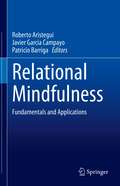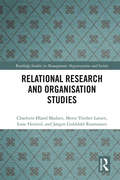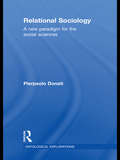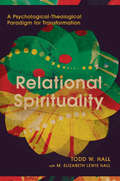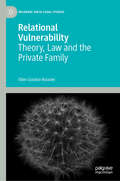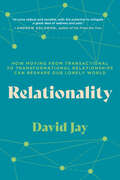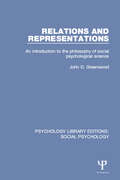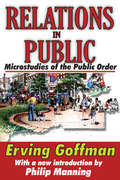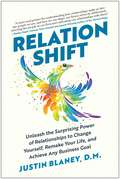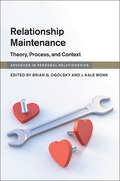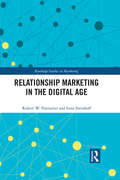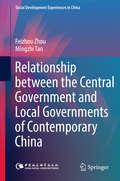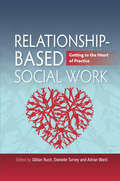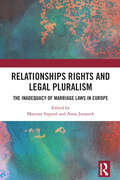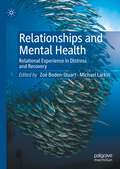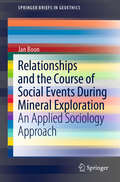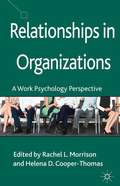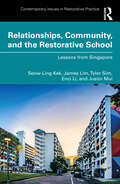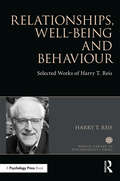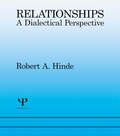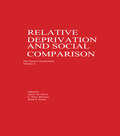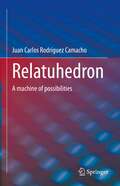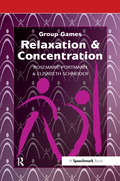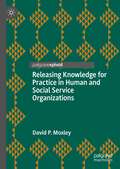- Table View
- List View
Relational Mindfulness: Fundamentals and Applications
by Roberto Aristegui Javier Garcia Campayo Patricio BarrigaThis book proposes a new approach to mindfulness-based interventions, presenting them not as individual, but as relational practices. In the last decades, mindfulness has exerted a growing influence on many fields of research and activity, but always as an individual practice. The authors in this volume believe that the strong development of mindfulness today implies considering a dialogue between this individualistic approach and the perspective of relational mindfulness based on social constructionism. The volume is organized in two parts. The first part focuses on the theoretical foundations of relational mindfulness. The second part presents possibilities of applications of relational mindfulness in clinical and organizational settings to promote mental health and personal development.Relational Mindfulness: Fundamentals and Applications will be of interest to a wide range of professionals interested in applying mindfulness-based interventions in mental health care and productive organizations, such as clinical and health psychologists, public health professionals and human resources analysts and consultants, among others. "It is true that the metaphor of mindfulness has been enormously fruitful in its invitation to innovate. By removing meditative practices from their ancient roots, practitioners were free to create practices especially relevant to context. (…) At the same time, there was also a recognizable loss in the profoundly rich heritage that was left behind. For many of us, the greatest loss resulted from the absorption of such practices into Western individualism. What had once been an orientation to practice emphasizing our fundamental inter-being, had become a gateway to silent separation. It is in this context that the present volume bursts into significance. With special appreciation to the editors of this book, we are treated to a multi-dimensional exploration into the relational dimensions of mindfulness practices. Bringing ideas, experience, and wisdom from across professions, and across continents the contributors open an exciting path to the future." - Excerpt from the Foreword by Kenneth J. Gergen
Relational Research and Organisation Studies (Routledge Studies in Management, Organizations and Society)
by Lone Hersted Charlotte Øland Madsen Mette Vinther Larsen Jørgen Gulddahl RasmussenThis volume lays out a variety of ways of engaging in research projects focused on exploring the everyday relational practices of organizing and leading is presented. The main focus is through elaborate examples from the author’s own research to further the understanding of how it is possible to carry out relational constructionist research inquiries. The book presents a series of examples ranging from conversations with top-managers, relational action learning processes in management groups, polyphonic inquiries for project management teams, transformative roleplaying in organizations, analyzing organizational dialoguing, and polyphonic future-forming ways of writing up research. Relational Research and Organisation Studies does not only present and discuss guidelines for practice at a onto-epistemological level but also presents and discusses concrete cases of research projects building on relational constructionist ideas. Furthermore, excerpts of data are presented and analyzed in order to explain the co-constructed processes of the inquiries more in detail. Relational Research and Organisation Studies invites the reader into the process of planning and carrying out relational constructionist research inquiries. Based on the authors own experiences, it inspires readers to develop their own relational inquiries within the field of organizing.
Relational Sociology: A New Paradigm for the Social Sciences
by Pierpaolo Donati‘Simultaneous invention’ has become commonplace in the natural sciences, but is still virtually unknown within the sphere of social science. The convergence of two highly compatible versions of Critical Realism from two independent sources is a striking exception. Pierpaolo Donati’s Relational Sociology develops ‘upwards’ from sociology into a Realist meta-theory, unlike Roy Baskhar’s philosophy of science that works ‘downwards’ and ‘underlabours’ for the social sciences. This book systematically introduces Donati’s Relational Sociology to an English readership for the first time since he began to advance his approach thirty years ago. In this eagerly awaited book, Pierpaolo Donati shifts the focus of sociological theory onto the relational order at all levels. He argues that society is constituted by the relations people create with one another, their emergent properties and powers, and internal and external causal effects. Relational Sociology provides a distinctive variant upon the Realist theoretical conspectus, especially because of its ability to account for social integration. It will stimulate debate amongst realists themselves and, of course, with the adversaries of realism. It is a valuable new resource for students of social theory and practising social theorists.
Relational Spirituality: A Psychological-Theological Paradigm for Transformation (Christian Association for Psychological Studies Books)
by Todd W. HallAs our society becomes more socially fragmented, many Christians feel disconnected and struggle to grow spiritually. Common models of spiritual transformation are proving inadequate to address "the sanctification gap." In recent decades, however, a new paradigm of human and spiritual development has been emerging from multiple fields. It's supported by a critical mass of evidence, all pointing to what psychologists Todd W. Hall and M. Elizabeth Lewis Hall call a relational revolution. In Relational Spirituality, Hall and Hall present a definitive model of spiritual transformation based on a relational paradigm. At its heart is the truth that human beings are fundamentally relational—we develop, heal, and grow through relationships. While many sanctification models are fragmented, individualistic, and lack a clear process for change, the relational paradigm paints a coherent picture of both process and goal, supported by both ancient wisdom and cutting-edge research. Integrating insights from psychology and theology, this book lays out the basis for relational spiritual transformation and how it works practically in the context of relationships and community. Relational Spirituality draws together themes such as trinitarian theology, historical and biblical perspectives on the imago Dei, relational knowledge, attachment patterns, and interpersonal neurobiology into a broad synthesis that will stimulate further dialogue across a variety of fields. Highlighting key characteristics of spiritual communities that foster transformation, Hall and Hall equip spiritual leaders and practitioners to more effectively facilitate spiritual growth for themselves and those they serve.
Relational Vulnerability: Theory, Law and the Private Family (Palgrave Socio-Legal Studies)
by Ellen Gordon-BouvierThis book breaks new theoretical ground by constructing a framework of ‘relational vulnerability’ through which it analyses the disadvantaged position of those who undertake unpaid caregiving, or ‘dependency-work’, in the context of the private family. Expanding on existing socio-legal scholarship on vulnerability and resilience, it charts how the state seeks to conceal the embodied and temporal reality of vulnerability and dependency within the private family, while promoting an artificial concept of autonomous personhood that exposes dependency-workers work to a range of harms. The book argues that the legal framework governing the married and unmarried family reinforces principles of individualism and rationality, while labelling dependency-work as a private, gendered, and sentimental endeavor, lacking value beyond the family. It also considers how the state can respond to relational vulnerability and foster resilience. It seeks to provide a more comprehensive understanding of resilience, theorising its normative goals and applying these to different hypothetical state responses.
Relationality: How Moving from Transactional to Transformational Relationships Can Reshape Our Lonely World
by David JayFor readers of Together and The Art of GatheringHow moving from transactional to transformational relationships and organizations can save our democracy, nurture our connections, and make us happier and healthier.Powerful institutions, from schools to tech and social media companies, create breeding grounds for isolation by failing to invest in relational work. This obstacle stands in the way of our fight for racial equity, economic justice, and climate resilience.In Relationality, leading asexuality and relationship activist David Jay brings clarity to the crisis with a fresh perspective that expands upon the fundamental idea that all entities in the universe are connected. Jay draws from a range of vivid personal experiences, including his time spent helping tech workers and policymakers reform social media.This book is for people who believe in the power of relationships and want to see increased investment in relational work. Its scientifically grounded framework will help readers foster conversations about relational work, establish conditions for relationships to thrive, and quantify the impact of them.Equipping professionals and activists involved in nonprofit, political, and other types of relational work with the knowledge they need to fight for and utilize resources, Relationality shares valuable insight on: The history of why institutions fail to invest in relationships Reimagining ROI calculations to account for relational workUsing tools of prediction and emergence theory to build communitiesHow stories and data about relationships can help us direct resources toward relational workRelational economics and the redistribution of wealthWith isolation and loneliness on the rise in a post-lockdown world, Relationality offers a roadmap to nourish our connections toward a better, more liberated world—personally, organizationally, and in community.
Relations and Representations: An introduction to the philosophy of social psychological science (Psychology Library Editions: Social Psychology #12)
by John D. GreenwoodWhat is the nature of social psychological science? What does a realist approach to human behaviour offer? Originally published in 1991, this lucid introduction to the philosophy of social psychological science takes a new and original approach to the subject. The author repudiates traditional empiricist and hermeneutical accounts, advancing instead a realist philosophy of social psychological science that maintains objectivity while at the same time stressing the social dimensions of mind and action. The author provides novel perspectives on the problems and potential of those sciences concerned with human behaviours that are constituted as meaningful actions by their social relational, and representational dimensions. He focuses in particular on the social identity of human actions and psychological states, on the objectivity of theoretical description and causal explanation, and on the role of experimentation. This approach, aimed at reconciling our scientific interest with our human intuitions, results in a richer conception of social psychological theory and phenomena than was found in most contemporary theoretical accounts. A stimulating and thought-provoking text, this title will still be of special value to students and teachers of psychology, sociology, anthropology and philosophy.
Relations in Public: Microstudies of the Public Order (Pelican Ser.)
by Erving GoffmanUntil recently, to be in a public place meant to feel safe. That has changed, especially in cities. Urban dwellers sense the need to quickly react to gestural cues from persons in their immediate presence in order to establish their relationship to each other. Through this communication they hope to detect potential danger before it is too late for self-defense or flight. The ability to read accurately the informing signs by which strangers indicate their relationship to one another in public or semi-public places without speaking, has become as important as understanding the official written and spoken language of the country.In Relations in Public, Erving Goff man provides a grammar of the unspoken language used in public places. He shows that the way strangers relate in public is part of a design by which friends and acquaintances manage their relationship in the presence of bystanders. He argues that, taken together, this forms part of a new domain of inquiry into the rules for co-mingling, or public order.Most people give little thought to how elaborate and complex our everyday behavior in public actually is. For example, we adhere to the rules of pedestrian traffic on a busy thoroughfare, accept the usual ways of acting in a crowded elevator or subway car, grasp the delicate nuances of conversational behavior, and respond to the rich vocabulary of body gestures. We behave differently at weddings, at meals, in crowds, in couples, and when alone. Such everyday behavior, though generally below the level of awareness, embodies unspoken codes of social understandings necessary for the orderly conduct of society.
Relationshift: Unleash the Surprising Power of Relationships to Change Yourself, Remake Your Life, and Achieve Any Business Goal
by Justin BlaneyLearn to leverage your relationships so you can dream bigger, achieve whatever you want, and build a life that makes you happier with each passing day. No greater force for change exists than the people we surround ourselves with. Relationshift explores how the people in your life have colored your worldview, how this limits or expands your options, and what to do about it. Through the stories of British explorer Gertrude Bell, abolitionist hero Frederick Douglass, music icons the Beastie Boys, and many others, this book will help you: Learn how to connect with high-caliber people who can help you go further in life. Understand the rules of life as handed down through countless generations—then learn how to recognize which ones can be bent. Grow in happiness, thankfulness, peace, and contentment while eliminating the power of negative emotions. Explore how our minds reject new concepts like our bodies reject viruses. Build a personal tribe that can help you achieve any goal in work, health, or relationships. Make better choices by learning to see your options more clearly and honing your ability to move quickly with less information. Identify relationships that have the most impact on your wellbeing, for better or worse. Discover and refine the direction of your life by exploring wisdom from twenty experts on purpose. With dozens of illustrations and practical examples, Relationshift will help you take greater control of your life and uncover a path to your best possible future.
Relationship Maintenance: Theory, Process, and Context (Advances in Personal Relationships)
by Brian G. Ogolsky J. Kale MonkRelationship maintenance encompasses a wide range of activities that partners use to preserve their relationships. Despite the importance of these efforts, considerably more empirical focus has been devoted to starting (i.e. initiation) and ending (i.e. dissolution) relationships than on maintaining them. In this volume, internationally renowned scholars from a variety of disciplines describe diverse sets of relationship maintenance efforts in order to show why some relationships endure, whereas others falter. By focusing on 'what to do' rather than 'what not to do' in relationships, this book paints a more comprehensive picture of the forms, functions, and contexts of relationship maintenance. It is essential reading for scholars and students in psychology, communication, human development and family science, sociology, and couple/marriage and family therapy.
Relationship Marketing in the Digital Age (Routledge Studies in Marketing)
by Robert W. Palmatier Lena SteinhoffThe concept of relationship marketing has been discussed among marketing academics and managers since the early 1980s. But instead of reaching its maturity stage, relationship marketing is nowadays encountering its next upsurge. Due to a confluence of trends driving the global business world—including the transition to service-based economies, faster product commoditization, intensified competition worldwide, growth among emerging markets, aging populations, advertising saturation, and (above all) the digital age—strong customer relationships are more than ever vital to company strategy and performance. Relationship Marketing in the Digital Age provides a comprehensive overview of the state-of-the-art of relationship marketing, offering fruitful insights to marketing scholars and practitioners. In seven chapters, divided into two main sections on understanding (Part I) and effectively applying (Part II) relationship marketing, an introductory and a concluding chapter, readers learn how to successfully manage customer–seller relationships.
Relationship between the Central Government and Local Governments of Contemporary China (Social Development Experiences in China)
by Feizhou Zhou Mingzhi TanThis book examines the connection between central-local government relations and the transition of contemporary China, the urbanization process and social development. Based on empirical investigations and theoretical research, it argues that this is the key to understanding the transition of central-local government relations from the overall fiscal rationing system in the 1980s and the tax distribution system in the 1990s. The former system provided the incentive for local government to “set up a number of enterprises” and resulted in rapid local industrialization, while the latter system enabled the local governments to move from “operating the enterprises” to “operating the land and cities”. The book analyzes two aspects of the profound impact of the change in central-local government relations on the behavior of local governments: land quota acquisition and urbanization, thus providing valuable insights into the economic and social development of contemporary China.
Relationship-Based Social Work
by Edited by Gillian Ruch Danielle Turney Adrian WardRelationship-based practice is founded on the idea that human relationships are of paramount importance and should be at the heart of all good social work practice. This book provides a thorough guide to relationship-based practice in social work, communicating the theory using illustrative case studies and offering a model for practice. Case examples cover the different service user groups including children, families, older people, refugees, people with disabilities and people with mental health difficulties. The book explores the ranges of emotions that practitioners may encounter, and covers working in both short-term and long-term relationships. It also outlines key skills for the individual such as how to establish rapport with the client and using empathy to build a relationship, and explores systemic issues such as incorporating service user perspectives and building appropriate support systems for practice, management and leadership. This book will be an invaluable textbook for undergraduate and post-graduate social work students, practitioners on post-qualifying courses and all social work and allied professionals.
Relationships Rights and Legal Pluralism: The Inadequacy of Marriage Laws in Europe
by Mateusz Stępień Anna JuzaszekThis interdisciplinary book brings together leading social and legal scholars to tackle the incompatibility of marriage laws with contemporary social reality in Europe. Their critique is based on the assumption that individuals should be able to choose how they organise their close relationships. The contributors emphasise the importance of pluralism of beliefs, values, cultures, and lifestyles and the consequent need for legal recognition to make individuals' private choices valid and respected. The first part of the book establishes the foundation for the subsequent chapters by exploring the advantages and challenges of focusing on values while accommodating relationship design plurality, the impact of the European Court of Human Rights on the issue, and the transformation of the institution of marriage. The second part presents different legal responses to non-state marriages, particularly religious marriages among Muslim communities, and proposals for reform. The third part of the book features empirical research on the marital experiences of two communities: Muslims and migrants. The chapters concentrate on polygyny among female converts to Islam, the importance of religious knowledge for practising Muslim women in securing rights in their marital relationships, transnational and interreligious marriages, and the impact of acculturative orientation and position in the dual labour market on the choice of life partner among Polish migrant women. The book will be of interest to academics, researchers, and policymakers working in the areas of human rights law, family law, legal anthropology, law and religion, socio-legal studies, feminism and queer studies, and sociology of family.
Relationships and Mental Health: Relational Experience in Distress and Recovery
by Michael Larkin Zoë Boden-StuartThis interdisciplinary edited volume examines the complexities of relational life in the context of psychological distress and recovery. It is well documented that supportive, close relationships are central to wellbeing. This volume explores how connectedness is shaped by mental health settings, interventions and mental health experiences - and vice versa. In doing so, this work provides important insights for adult mental health care, where systems and settings can often struggle to take account of the relational context of distress and recovery. This is the first book to address the emerging shift towards a relational account of distress and recovery through a focus on people's experiences. Chapters explore community and statutory service settings, privileging the voices of those experiencing distress, their loved ones and the professionals who work with them. It also extends recent interest in the role of loneliness and social isolation in mental health, to consider themes such as belonging, connection, care and intimacy. It will appeal to mental health practitioners as well as academics in the fields of psychology, sociology, psychotherapy, psychiatry, social policy and social work.
Relationships and the Course of Social Events During Mineral Exploration: An Applied Sociology Approach (SpringerBriefs in Geoethics)
by Jan BoonThis book provides the results of nine case studies of the course of social events in mineral exploration projects (mostly in Latin America). The author concluded that, while each case is sui generis, the underlying sociological processes are the same. This made it possible to develop a generalized model for the course of social events during mineral exploration. It consists of seven stages: (i) arrival of the project; (ii) initial meanings, interpretations and decisions; (iii) real dialogue; (iv) building relationships; (v) change processes; (vi) new relationships and social structures and (vii) the course of social events and perceived benefits and harms. Stages (iii) => (iv) => (v) => (iii) form a continuous iterative cycle. Dialogue and relationships are at the heart of the model. The text describes five of the nine case studies in some detail and illustrates how sociology explains the sociological processes in these projects. These examples, together with the final chapter that discusses the implications, provide many practical pointers for all actors involved: industry, communities, NGOs, home governments and host governments.
Relationships in Organizations: A Work Psychology Perspective
by Rachel Morrison Helena Cooper-ThomasThis book is an exploration into the current world of relationships in the workplace. It focuses on the ways in which organizational relationships - be they friendships, superior-subordinate relationships, negative relationships, romantic liaisons or simply membership to a social network - can influence and affect our experience of work.
Relationships, Community, and the Restorative School: Lessons from Singapore (Contemporary Issues in Restorative Practices)
by James Lim Tyler Sim Enci Li Justin Mui Seow-Ling KekThis book shares our journey with restorative practice and provides insight into how we developed a programme that impacts school culture – the Builders Project. It is a documentation of our experience of bringing restorative practice to primary school settings in Singapore, through a whole-school community building approach, to enable students to have a positive learning experience and to thrive. This contrasts with implementing restorative practice focusing on behavioural management. It is the first non-Western contribution to the field of restorative practices as a whole-school approach.This book shares Lutheran Community Care Services (LCCS) practice assumptions that underpin the need to build, strengthen, and restore relationships. It also illustrates the application of our restorative practice principles, which are drawn from our experience, values, and research, towards building effective relationships among the individuals in the school community. Stories and perspectives of practitioners, students, parents, teachers, and school leaders are shared to highlight how they experience voice, agency, and belonging through restorative processes. Most importantly, we hope that this book will inspire you to reflect on your journey with restorative practice in schools through the reflection questions posed in each of the substantive chapters.This book is for educators, school social work and mental health practitioners, educational policymakers, school administrators, principals, academics, researchers, and restorative practice practitioners. This book is also suitable for undergraduates or postgraduate students who desire to understand practice beyond the theories that they have learnt and gain insights on what the journey of practicing and implementing restorative practice looks like.
Relationships, Well-Being and Behaviour: Selected works of Harry Reis (World Library of Psychologists)
by Harry ReisIn the World Library of Psychologists series, international experts themselves present career-long collections of what they judge to be their finest pieces - extracts from books, key articles, salient research findings, and their major practical theoretical contributions. In this fascinating volume, Harry Reis reflects on a career that has earned him an international reputation as an eminent scholar and pioneer in the field of relationship science, through a selection of papers that illustrate the foundational theme of his research career: the importance of relationships for human well-being. The book charts the development of research in social psychology and relationship science through three key themes; from the relationship context of human behaviour, through to the value of studying behaviour in its natural context, and finally intimacy and responsiveness in close relationships. Also featuring a newly written introduction by the author contextualizing the selections and offering an intimate overview of his career, this collection of key publications offers a unique and compelling insight into decades of groundbreaking work, making it an essential resource for all those engaged or interested in the psychology of relationships and well-being.
Relationships: A Dialectical Perspective
by Robert A. HindeThis volume on close relationships in adulthood discusses the central issues in the field and points the way towards the construction of an integrated body of knowledge about human relationships. The self, interactions, relationships and grops are treated as dynaimc proceses in dialectical relations with each other and with the socio-cultural structure of norms, values, beliefs and institutions.; Early chpaters introduce aspecs of the slef relevant to the dynaimcs of intercayions and relationships: Intrapsychic Processes Of Cognition And Emotion Are Emphasized. These Are followed by chapters discussing the principle characteristics of relationships. Seven further chapters focus on the processes involved in the dynaimcs of relationships, and later chapters synthesize previous ones in discussions of love and friendship, and the nature of relationship change. The focus throughot the text is on current work and current controversy, placed against a background of knowledge that has been built up in recent decades.
Relative Deprivation and Social Comparison: The Ontario Symposium, Volume 4 (Ontario Symposia on Personality and Social Psychology Series)
by JAMES M. OLSON, C. PETER HERMAN and MARK P. ZANNAFirst published in 1986. Routledge is an imprint of Taylor & Francis, an informa company.
Relatuhedron: A machine of possibilities
by Juan Carlos Rodriguez CamachoA journey of new routes of healing with/by Indigenous and non-Indigenous participants is shared under the Two Eyed-Seeing Perspective of Elder Albert Marshall. The Universal Human Right of Indigenous self-determination and Relationality are the togetherness presented in a “mangrove tree” that lives between salty and sweet waters emerging as a protective place of rich ecosystems. The relatuhedron (shapes of relationality) a co-construction of a home, a Wigwam, Long House, Maloca, Ue, crystalizes knowledge and practices in the process of individual and community healing and cultural transactions. A set of neologisms such as relatuhedron, pedagomiologies, and social grammars, is proposed to challenge our views of mental health, healing, cultural transactions, stereotypes, recovery, and public policy and include simplicities and complexities required to support Indigenous well-being. It is a “machine of possibilities” for students and professionals working with/by and for Indigenous communities. In this book healing is presented as a process through scholarly practice and reflection. Healing is a process of emergence of meaning by improving relationality with the self, nature and others, in a practical approach to socio-cultural transformations. In sum, healing is based on individual and community processes both honoring and respective Indigenous knowledge and scientific research to create endless opportunities for well-being. This book presents healing as a process of growth, a complex, dynamic and evolutive journey of transforming how we stablish and maintain relationships with the self, nature and others inside of our cultural negotiations.
Relaunching Titanic: Memory and marketing in the New Belfast
by Michael Murray William J. V. Neill Berna GristRelaunching Titanic critically considers the invocation of Titanic heritage in Belfast in contributing to a new ‘post-conflict’ understanding of the city. The authors address how the memory of Titanic is being and should be represented in the place of its origin, from where it was launched into the collective consciousness and unconscious of western civilization. Relaunching Titanic examines the issues in the context of international debates on the tension between place marketing of cities and other alternative portrayals of memory and meaning in places. Key questions include the extent to which the goals of economic development are congruous with the ‘contemplative city’ and especially the need for mature and creative reflection in the ‘post-conflict’ city, whether development interests have taken precedence over the need for a deeper appreciation of a more nuanced Titanic legacy in the city of Belfast, and what Belfast shares with other places in considering the sacred and profane in memory construction. While Relaunching Titanic focuses on the conflicted history of Belfast and the Titanic, it will have lessons for planners and scholars of city branding, tourism, and urban re-imaging.
Relaxation & Concentration (Group Games Ser.)
by Don Bosco VerlagThis set of four books offers a variety of games and activities that facilitate a positive and fun learning experience for people of all ages in their emotional and behavioural development. The games and activities are suitable both for individuals and groups, and take a positive and proactive approach to the areas of: self-esteem, aggression, relaxation and concentration, and social skills. This volume contains 130 games to promote relaxation and concentration: Includes games for reducing restlessness and agitation, calming and awareness, attention and thinking, and concentration for the whole body.
Releasing Knowledge for Practice in Human and Social Service Organizations
by David P. MoxleyThis book will advance readers’ understanding of the knowledge development, building and/or management process within human service organizations, informed by the author's experience in human service organizations, as consultant, and practitioner. Readers can come to understand the knowledge building process, and gain a conceptual framework in building organizational knowledge for the advancement of human services practice. The importance of knowledge management in social welfare and human service is twofold. Knowledge management is about an organization managing what it knows in order to achieve more competent and more effective performance. It also is about how domains and fields of practice may transform themselves over time through the purposeful creation and destruction of knowledge. Knowledge management can be a cornerstone of today’s human service and social welfare organizations and may be a principal strategy for effecting innovation and evolution in the ways societies address and meet human needs.
